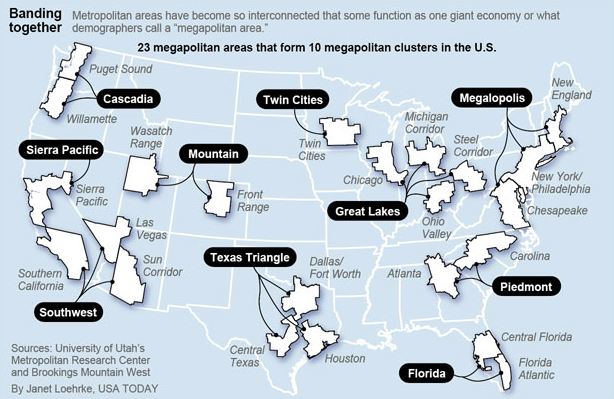The New Geography of Megapolitan Communities
Sam Rainer
USA Today recently published a graphic that grabbed my attention. As shown below, this graphic reveals what some demographers predict will become “megapolitan” communities. While I might draw the lines differently on some of the physical boundaries of these communities, the concept of megapolitan areas is fascinating to me.
The article (which reports on this book) defines these megapolitan areas as “having at least one metropolitan area of 2 million people by 2040 that’s connected — via commuting patterns — to at least one other metro area of more than 250,000 people. A megapolitan cluster has several megapolitan areas that are connected by commuting, trucking or commuter airline and share terrain, climate, culture, economic base and political culture.”
Here are a few of the presuppositions of these future mammoth communities:
- They will encompass major cities and counties, sharing a common culture, geographical features, transportation networks, and water supplies.
- Economic and population growth will continue to occur unevenly (in favor of urban areas), which means more collaborative and regional planning across communities in the future.
- Globalization will force U.S. regions to merge in order to stay competitive.
- Urbanization will continue to accelerate.
- Larger communities will create more jobs simply because of scale.
How this geographic and sociological change will affect the church is pure speculation. But it’s fun to speculate. I could see regional mega-churches benefiting from this shift, as well as regional multi-site churches. However, the inevitable regionalism of this shift may also create a localized neighborhood effect, in which people within a larger region desire to be identified with a specific and unique part of their community. As such, smaller neighborhood churches may also be positioned well. I’m curious about your thoughts. How else might this change—if it comes as predicted—affect the church? How can the church begin to respond?








Fascinating! Regardless of the outcome I believe the preparation must be the same – plant more churches to reach more people.
This is fascinating. I live in Dallas Co and it is seems to never end. The idea that it would one day ‘touch’ Austin is odd. The growth would need to completly shift thou, DFW grows North and East not South. If all things stayed the same it would hit OKC first.
I am leading our church intentionally toward the neighborhood identity you mentioned. As I see it, this is the best approach. My POV has more to do with cooperation w like minded churches.